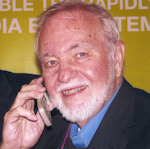Download the full article as a .PDF, sponsored by Analog
What is a short-range radio?
A short-range radio or short-range device (SRD) is a highly integrated transceiver usually on a single chip that’s used to implement a wide range of wireless data applications.
What are the operating frequency ranges of these transceivers?
Most single-chip transceivers operate in the industrial-scientific-medical (ISM) bands set aside for unlicensed wireless data applications. Popular U.S. frequencies include 315, 433, and 902 to 928 MHz, as well as 2.4 to 2.5 GHz and 5.7 to 5.8 GHz. In Europe, 868 MHz is popular.
What frequency should I choose?
It depends. You can transmit over longer distances on the lower frequencies. Yet the tradeoff is antenna size, as the lower frequencies need much longer antennas. Also keep in mind that some frequency bands, especially the 2.4- to 2.5-GHz range, are loaded with traffic from Wi-Fi local-area networks (LANs), Bluetooth, cordless phones, ZigBee, microwave ovens, and lots of other stuff that could interfere with your application. However, the 2.4-GHz band is universally available worldwide, reducing the need to have multiple designs for different countries or regions.
Is any kind of FCC license required to use these devices? No license is needed, especially if you select commercial chips designed for the specified ISM bands. But the final end product still must undergo FCC testing to certify that it meets the ISM rules and regulations. If you’re planning to make wireless ISM products, you need to read the relevant rules and regulations. These can be found in Part 15 of Title 47 of the Code of Federal Regulations (CFR), downloadable at www.fcc.gov. Take a look specifically at sections 15.231 to 15.249.
What are some of the more widely used applications?
Many are familiar, like garage door openers, remote keyless entry on cars, tire pressure monitoring, remote thermometers, wireless sensor telemetry, and remote-control toys. Home and building automation represents a major category. Other uses include remote automatic meter reading for utilities, security systems, wireless patient monitoring, industrial process control, and consumer electronics remote controls.
How do these short-range radios compare to other wireless devices using Bluetooth, Ultra-Wideband (UWB), Wi-Fi, or ZigBee? Bluetooth, UWB, Wi-Fi, and ZigBee are designed for applications usually in a specific field. Short-range transceivers are used in applications where only a simple point-to-point or point-tomultipoint connection is needed and no networking of devices is necessary.
What kind of RF power output levels do short-range transceivers use?
Most power levels are in the 1-mW or 0-dBm to 100-mW or 20-dBm range. The total transmitted power also is affected by the gain of the antenna, which shows up as higher received power. This is expressed as equivalent isotropic radiated power (EIRP).
What kind of range can one expect from a short-range transceiver?
The range depends on many different factors, including frequency of operation, transmitter power, antenna gain, distance between transmitter and receiver, height of the antenna, receiver sensitivity, and environmental conditions like obstructions or indoor usage. The range may be only a few feet to many kilometers.
What kind of data rate can be achieved with these transceivers?
Low speed in the 1- to 10-kbit/s range is the most common. The usual rate is almost always under 200 kbits/s.
What’s inside a typical short-range transceiver?
The figure shows a typical transceiver designed for 433-, 868-, and 915-MHz ISM band applications. It can be set up for frequency shift keying (FSK), Gaussian filtered FSK, amplitude shift keying (ASK), and Gaussian filtered on-off keying (OOK). It supports data rates from 300 bits/s to 200 kbits/s. The receiver sensitivity varies with data rate and desired bit error rate (BER) but ranges from –106.5 to –119.2 dBm. The transmit power is programmable from –16 to 13 dBm in 0.3-dBm steps.
Can you provide any suggestions for antenna selection or design?
Some external discrete inductors and capacitors are usually required to match the antenna to the transceiver. Simple antennas like a half-wave dipole or quarter-wave ground plane usually work fine. You can also use a loop antenna. The dipole or loop can sometimes be made right on the printed-circuit board (PCB). There are also many manufacturers of suitable commercial antennas.
What kind of data protocol should I use?
Short-range devices let you create your own protocol. You’ll most likely transmit data in short packets to minimize power consumption. Your protocol may use an address to identify a specific wireless point. Transmit or receive data will be in byte form. Multiple transmissions may be used for redundancy to improve transmission reliability.
What are some useful design tips in selecting an ISM product?
First, 900-MHz radios will provide a longer range and better penetrate walls and other obstacles than 2.4-GHz radios. Second, some applications may only require a remote transmitter, so a less expensive transmitter chip with lower power consumption can be used. Third, a faster data rate will let the TX send its data and then go back into its power-down mode sooner.
Product Q&A
Short-Range RF TransceiversADI SRD Design StudioTM With ADI’s SRD Design Studio, the development of short-range wireless systems has never been easier. This popular development tool allows for the creation and optimization of short-range wireless systems in no time before going to the lab. ADI’s SRD Design Studio allows for real-time simulation and optimization of many of the parameters in the system using the ADF7xxx family of transceivers and transmitters. The development tool is based on the ADIsimPLL™ tool, and it has been enhanced to allow users to view modulation in both the time and frequency domains. Furthermore, the ADI SRD Design Studio greatly simplifies the overall development process by creating a path along which a user can be guided and breaking down the design workflow into a number of distinct tasks. The ADI SRD Design Studio is available for free and can be downloaded at https://form.analog.com/Form_Pages/RFComms/SRDDesignStudio.aspx.
Learn more about ADI’s short-range transceivers at www.analog.com/srd.

